|
|
|
 |
|
“ON THE MORNING OF
THE THIRD DAY THERE WAS THUNDER
AND LIGHTNING, AS WELL AS A THICK CLOUD ON THE MOUNTAIN,
AND THE SOUND OF A SHOFAR SO LOUD THAT
ALL THE PEOPLE WHO WERE IN THE CAMP TREMBLED”
EXODUS 19:16
|
|

- We recently bought a
shofar from e-bay. It is a beautiful
instrument that we have wanted to own for a long
time. We received the shofar in a lovely
navy blue bag with Hebrew writing on it.
According to the lady who sold it to us, it reads
“Blow the trumpet at the appointed time.”
We are very pleased with it except for the fact
that it has a terrible odor. We e-mailed the
seller and asked for advice on what to do about
the smell. Her response was that all real
shofars smell as ours does. She said she had
heard of someone using gravel and vinegar to
remove the smell, but did not go into details
beyond that.
Is it true that shofars do have a strong smell to
them? If so, could you help us by telling us
what we could do to eliminate some or all of the
smell? We would love to learn to use it, but
as you can see it’s not very inviting.
Gary & Eva Hancock, Melbourne, Florida
|
I myself have never
owned, blown or cleaned a shofar. But my
friend Sylvia from Shoreline, WA, who was in a group
of pilgrims I guided several months ago, is a shofar
expert. While we were on tour she checked out
every single shofar we saw and then went down into
the storerooms to inspect and test those not yet on
display. I even sent her to a dusty shofar
“factory” in the industrial section of Jerusalem.
The following advice is from her website,
www.eaglevine.net.
The shofar comes from the horn of a ram (a male
sheep) or goat or antelope (kudu). The Yemenite Jews
did not have sheep or goats, so they used the horn
of the antelope. Most animal horns can be
used, except for the cow, which is reminiscent of
the golden calf.
|
|
 |
|
Photo: Gila
Yudkin |
|
Testing a Yemenite
shofar from the horn of an antelope |
| |
| Scripture tells us
that a ram was caught in the thicket at Mount Moriah
and sacrificed instead of Isaac. The first
blowing of the shofar was when God called the people
to worship at Mount Sinai. The first shofars
would have been ram’s horns, which were available
only after the death of the animal. Horns are
made of live protein like fingernails and hoofs.
The smell is caused by blood-eating bacteria that
remain within the shofar. Here's how to reduce
or eliminate the smell. |
| |
1. Make sure that you are wearing old clothes,
for the bleach can spot good clothes.
2. Plug the mouthpiece with an earplug and finger
cotton.
3. Fill with scented bleach and wedge so that the
large opening sits upward. Be careful of the
outside finish.
4. Leave for about 20 minutes – no more, for the
bleach is very drying. Then pour out the
bleach. If the odor is very bad, then you
may have to repeat the process for a shorter time.
5. Rinse with water. You may want to put in
some peroxide to see if it will bubble more out of
the bone.
6. Rinse again and then put alcohol in to help dry
it. Use brushes and pipe cleaners in the
openings.
7. Fill with borax and leave for a time. (Sylvia
says she has left the shofar for a couple of days,
even.) Afterwards, make sure you get all the
borax out, using the brushes and pipe cleaners.
8. Finish by rubbing oil inside and roll the oil
around to cover the inside and rub it on the
outside. Oil your shofar periodically as it
was living protein and this will keep it from
cracking.
|
| Sylvia wrote me that
she thinks the younger the animal, the more
blood-eating bacteria are left in the bony
structures. She nicknames the smell
shofartosis. |
| |
|
 |
|
Photo: Gila
Yudkin |
|
A
ram with its horn |
| |
|
If you already have a shofar
like Joshua, do you have a sling like David??
Check out the "traditional"
sling
that killed Goliath |
|
|
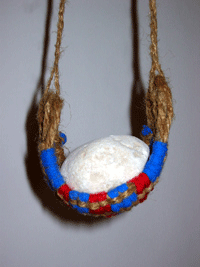 |
“THE
SLINGSHOT THAT KILLED GOLIATH”
Just
kidding. But this “traditional”
slingshot, woven
in Bethlehem, David's hometown, makes a singular
gift for anyone who wants to emulate David, and have
fun doing it! Use it as a visual for Sunday
School Bible classes and as a prop for David and
Goliath skits. The slingshot is accompanied by a
three-page commentary
on the famous duel: the geographical setting, its
historical roots and the “smoking sling.”
The slingshot comes without the stone – but to
give you a sense of size, the stone is 2.5 inches in
diameter, similar to the real size of the stone
David would have picked up from the river bed.
The stone that hit Goliath’s forehead was not a
pebble! |
|
|
|
|
|
I also asked my
friend Moshe Falkof to share his expertise on this
question. For the past 30 years Moshe ends the
Yom Kippur (Day of Atonement) prayer service in the
synagogue at Kibbutz Ketura with a mighty blast of
the shofar. In his words,
“Referring to the smell – no, it is not the
smell of beautiful calfskin leather or a good steak.
The authorities on the issue recommend vinegar or
baking soda for removing odors. Pour the
vinegar into the shofar, or dissolve baking soda in
water and pour into the shofar. Rinse and
repeat. If necessary, let sit overnight in the
vinegar/baking soda solution.
Eliminating a strong odor is important,
because such an odor might lessen the honor of the
mitzvah (commandment), violating the principle
that “mitzvot should not be contemptible in
your eyes.” And if the odor is very bad, it’s
forbidden to say a blessing in its presence. I
might add that the treatment also softens up the
horn, leading to a less harsh sound." |
|
|
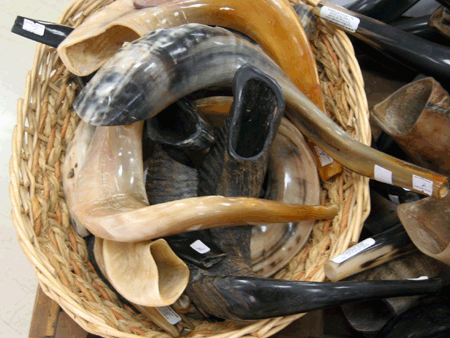 |
|
Photo:
Gila Yudkin |
|
Basket of
shofars from rams' horns |
|
|
Maintaining a Shofar |
|
- What kind of oil do
you put on the outside of the shofar?
Pastor Charles, Atlanta, Georgia
|
| According to one expert who has been selling shofars on Jerusalem’s Cardo for three decades, “There's no need to put oil on the outside of the
shofar cause it's a bone, a natural material. To
improve the sound, pour arak [a Middle Eastern stiff
drink with a licorice flavor] or lemon juice inside. Block the small end and shake the liquid inside.
Then let it drain out. A shofar is for blowing and
the most important thing is to maintain it for its
sound.” |
|
| Kibbutz Ketura Shofar-Blower Moshe Falkoff adds,
“Any light oil, such as a thin coat of olive oil,
might shine the horn a bit. But I don't think it is
necessary. Cleaning the inside with vinegar, which
is a very weak acid, is a good thing from year to
year. The important thing is to prevent breaks or
cracks that would make the shofar unkosher
[ritually unclean]. I
continue to bring my message (a different one each
year) via the shofar at the High Holidays. It is a
very serious responsibility.” |
|
|
Copyright 2006, 20016 Gila Yudkin. Permission
needed for any reuse. |
|
|
Holy Places where you might want to blow a Shofar |
|
|
 |
 |
 |
| Looking
out from Tel Jericho |
Joshua at Hazor |
Western Wall |
|
|
|
|
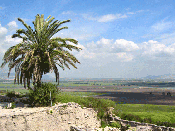 |
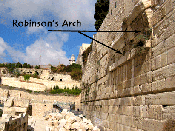 |
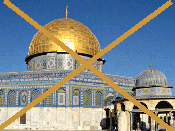 |
|
Armageddon! |
Robinson's Arch |
It's forbidden!!!! |
|
|
|
|
|
GILA
YUDKIN
•
TCHERNIKOVSKI
64A
•
JERUSALEM
•
ISRAEL
gila@itsgila.com
HOME
•BOOK
GILA
•
TIPS
FOR TOURS •
ABOUT GILA
|
|

